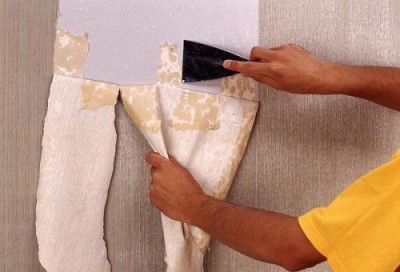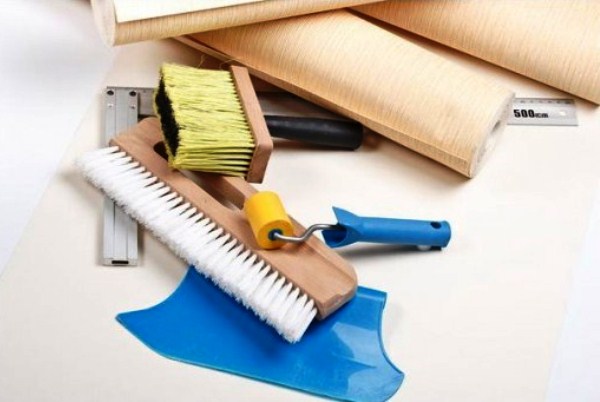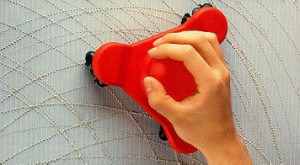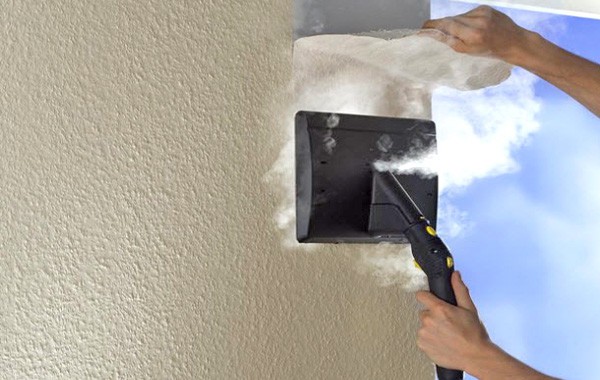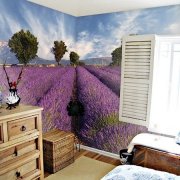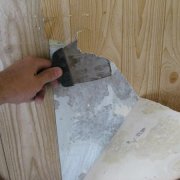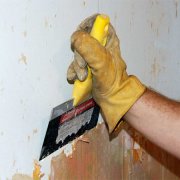How to remove old paper wallpapers without problems
On a paper basis, wallpapers periodically change to new ones. Removing the old coating is a rather difficult process, requiring both strength and time. The speed of cleaning the wall surfaces from them depends on several factors, the main ones are the type of material and the glue on which the sheets were glued. The article suggests getting to know how to remove old paper wallpapers from the wall with your own hands.
The content of the article
Features and types of paper wallpaper
The oldest known materials for wall decoration are paper wallpapers. If you previously glued overlays, then with a significant improvement in the quality of paper for wallpaper, reducing their thickness, more saturated and varied patterns, the method of gluing them has also changed - the seams have become joint, which is especially difficult to complete and requires more careful preparation of the walls, due to the thinness material.
If modern paper wallpapers are glued to the wall with old wallpaper, without removing them, then after drying:
- All wallpapers are very stretched. In this case, any irregularities, roughnesses become the reasons due to which the material will lag behind the wall.
- There are dust or stains on old coatings. There is no likelihood that they will not tread on new ones, especially if this wallpaper is white paper, and will not "decorate" the room after repair.
- New canvases can simply stick poorly over old ones.
- The glue used for gluing new wallpapers contains water, which will soften the old layer unevenly. This will lead to the formation of bubbles in one place and strong bonding of the material in another.
Tip: In order to prevent such troubles, you should be safe and thoroughly clean the wall of old material for decoration.
There are several types of paper wallpaper:
- Simplex or single layer.
- Duplex or wallpaper paper two-layer.
- Triplex or trilayer. This type of material has a large thickness, which makes it possible to hide some irregularities on the walls when glued correctly and, accordingly, they have a higher price.
- Wallpaper paper with acrylic. Otherwise, they are called embossed with acrylic coating. Such materials have great strength and durability. They are more moisture resistant when glued, do not get very wet, which distinguishes them from ordinary paper wallpaper.
- Moisture-resistant, washable paper wallpapers with latex coating.
The type of wallpaper glued determines the method of removing them from the walls. On old rolls, it is advisable to find a label or a special label, which shows symbols indicating the method of removing material from the walls.
It could be:
- Removal without residue.
- Removing wet.
- Peeling at removal.
- Embossing is not deformed.
- Wallpaper double embossed on the top layer.
Tip: If there is no label, you should use universal methods that allow you to dismantle old wallpapers.
Wallpaper Preparation
To quickly remove sheets from the walls, it is necessary to prepare tools and materials:
- Two spatulas: one wide and one narrow with sharp edges, so that they easily fit into the joints between adjacent panels of wallpaper. To do this, the edges of the spatula are sharpened with emery.
- Special liquid or plain warm water.
- To facilitate the work, you can use a household steam generator or steam mop.
- Knife.
- Wallpaper tiger or special needle roller. Such tools quickly make the surface perforated and facilitate the process of removing wallpaper.
- Masking tape.
- The film is polyethylene.
- Drywall cutting knife.
- Sponge.
- Capacity with water.
- Paint roller up to 25 centimeters wide.
This list may vary, depending on the type of wallpaper and the amount of work.
Before starting to remove:
- Take care to protect the floor, to which wet and sticky pieces can stick from old wallpaper - a plastic film is glued to the baseboard with masking tape around the perimeter of the room.
- Cover the switches and sockets with masking tape to prevent the elements from getting into the dirt and water.
How to quickly take paper wallpapers
Tip: Take a wallpaper should be wet. This will prevent the formation of dust, shedding of the plaster with a strong layer of glue available on the wall, it will be easier to remove glue on the surface.
Wet removal is performed using a special solution that penetrates deep into the wallpaper and dissolves the layer of existing old glue. This allows you to remove wallpaper from the surface without much difficulty. You can quickly remove the wallpaper with water.
Wallpaper dismantling instruction:
- The material is soaked with a garden spray or a regular sponge.
- Water should be absorbed well.
- If necessary, the procedure is repeated.
- 20 minutes should wait until the water soaks the dried glue, and the wallpaper will not easily fall behind the wall.
- The remaining places with wallpaper are re-wetted.
Tip: If you do not wet the walls with the wallpaper, the water will quickly absorb and dry before you completely soak the glue. If the wallpaper is very wet, the water will drain to the floor, and the surface of the walls again will not have time to get wet properly.
- Soak the wallpaper gradually, one place after another, periodically monitoring how the decoration material moves away from the wall.
- You need to start tearing off the wallpaper from the seam.
- If these places are dried up - they need to be moistened again.
- With extreme caution, old wallpapers are removed around switches, sockets, electrical meters and other electrical equipment.
- To comply with safety precautions, the power supply must be disconnected and only then the screws securing the shield are loosened.
- To remove material in hard-to-reach places, it is better to use a roller with spikes on a long handle, as in the photo.
- To speed up the process, it is better to use hot water.
- Some hard-to-remove pieces of old wallpaper can be removed carefully so as not to harm the plaster, scraper.
Removal of non-woven wallpaper
Durable synthetic fibers are part of non-woven wallpaper. The material has a waterproof layer.
To remove these wallpapers:
- Notches and holes are made on their surface.
- The wall is wetted with water with a regular sponge or spray.
- After about 15 minutes, the glue begins to swell.
- Wallpaper will begin to move away from the wall.
Removing vinyl wallpaper
This material is a high-strength vinyl film, combined with a paper base.
When removing them, you must:
- Scratch the surface of the wallpaper with a knife, wallpaper tiger or ordinary spatula.
- After the appearance of a sufficient number of cuts, the material is wetted with water for 20 minutes.
- This time is usually enough for moisture to get under the polymer layer and begin to dissolve the glue.
- A horizontal cut is made at the top of the wallpaper.
- The edge of the sheet is gently detached from the wall, pulling the canvas towards itself.
- Polyvinyl chloride is a sufficiently strong material that allows the wallpaper not to be torn to pieces, but immediately separated by whole strips.
- If there are residues of fragments of the paper layer on the wall, they are wetted with water and removed with a spatula.
There are heavy vinyl wallpapers, this can make them difficult to remove. Then remove them better in layers.
In this case, you will need:
- Metal brush.
- Wallpaper tiger.
- Special needle roller.
After the tool removes the protective moisture-resistant layer, you will need a device for removing the vinyl film, which is equipped with self-sharpening discs. In this case, the device, in contact with the wall, will perforate the outer layer, without damaging the wall.
Removing Washable Wallpaper
Washable wallpapers include two layers:
- The top, which is removed quite easily.
- The bottom stays firmly glued to the wall.
The layers are not afraid of moisture, which does not allow you to remove them in a simple way - by soaking the material. Further, to remove, you will need a gear roller or a metal scraper.
Then:
- With their help, notches are made.
- The entire surface of the wallpaper is wetted so that the water gets well under the coating and the wallpaper dries.
- After some time, you can try to shoot the wallpaper.
- If the glue soaked the water not well enough, you need to use a steam puller.
- After steaming one part of the surface, the steam sole is pressed against another.
- You can quickly remove the washable wallpaper using a conventional steam iron, replacing the steam generator.
Drywall Wallpaper Removal
Drywall is used for interior decoration (see Plasterboard ceilings and walls: tips from the master) Thanks to this material, any irregularities and surface defects can be smoothed out. But the lack of panels - it is very difficult to remove old wallpapers from them.
Removing drywall wallpaper is a rather complicated process. On top of the plate are covered with a paper layer - it can not be damaged.
When putty is put on a sheet of gypsum cardboard (see Drywall putty: practical tips and useful information), it is better to use chemicals that dissolve wallpaper glue. But even after such processing, you need to take off the wallpaper very carefully, you can not apply a lot of water, otherwise the surface of the drywall can be damaged. One convenient way to remove wallpaper is to use cheap glue.
In this case:
- The cheapest glue for wallpaper gets divorced.
- It is applied to the surface.
- Due to the long drying time, the wallpaper will swell and stretch.
- After that, they can easily be removed with a spatula.
Use of a primer is allowed. It saturates well the wallpaper, does not evaporate too quickly. When applying this method, the surface of the drywall sheets is primed at the same time. Residual material is removed with a spatula.
How to shoot white paper wallpapers, or any other, all the nuances and methods of work are shown in detail by the video.
